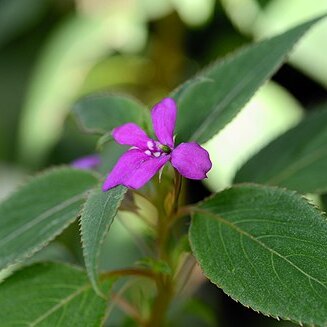Posterior sepal c. 7·5 × 2·5–3 mm., shallowly and obliquely navicular, abruptly constricted into the spur, distally acute or subcaudate, sparsely (rarely ± densely) pilose, glabrescent or glabrous, longitudinally striped (always?); spur very variable in length, 14–32 mm. long, slender, usually sharply incurved in the upper third, slightly incurved or nearly straight in the lower part, with the end bluntish or slightly thickened, usually glabrous, rarely pilose but then soon glabrescent.
Lateral united petals (10) 13–18 mm. long, deeply 2-lobed, usually glabrous, rarely shortly and sparsely hispid outside; lobes usually distinctly separated by a sinus, rarely overlapping; anterior lobe 8–13 × 4–7 mm., transversely oblique-elliptic, entire, the lower margin straight or slightly concave; posterior lobe a little smaller than the anterior one, obovate-oblong or obliquely elliptic, distally rounded, entire (see t. 26 fig. 15).
Flowers axillary, usually solitary, rarely in pairs or fascicles of three, pinkish, lilac, pink-magenta, or purplish; bracts up to 3·5 mm. long, subulate; pedicels (2) 3–6 (7) cm., slender, usually pilose, rarely glabrous, sometimes glabrescent.
Shrubby perennial herb, usually much branched, 25–60 (100) cm. high; stems erect or spreading, succulent, with swollen nodes, light green tinged with red or red, pilose (mainly on younger parts), glabrous or glabrescent.
Anterior petal 6–10 mm. high, 8–13 mm. broad (when flattened), dorsally cristate with the crest terminating in an acute point, somewhat pilose or glabrous.
Lateral sepals 2·9–6 × 0·8–2 mm., lanceolate, lanceolate-triangular or rarely ovate-oblong, often acuminate, pilose (sometimes glabrescent) or glabrous.
Seeds numerous, c. 2·25 × 1·5 mm., obovate in outline, light or reddish-brown, densely covered with very short thick conical multicellular hairs.
Capsule 0·8–1·6 cm. long, fusiform, glabrous.
Ovary glabrous.

